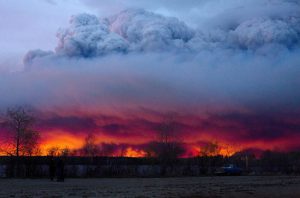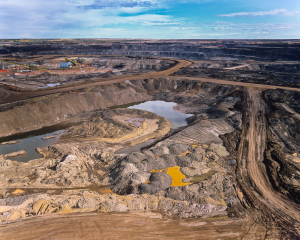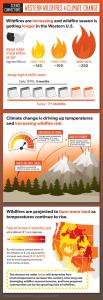 An out-of-control blaze consuming an area larger than Hong Kong has leveled the city of Ft. McMurray in Alberta, Canada and has displaced more than 88,000 residents. The blaze, described as a fire storm, began on May 1 with reports of smoke reaching as far as Florida. One firefighter on the scene, Capt. Danny Freeman, described the scene stating, “In 34 years, I’ve never seen devastation like that.” As of this writing, the fire continues to burn.
An out-of-control blaze consuming an area larger than Hong Kong has leveled the city of Ft. McMurray in Alberta, Canada and has displaced more than 88,000 residents. The blaze, described as a fire storm, began on May 1 with reports of smoke reaching as far as Florida. One firefighter on the scene, Capt. Danny Freeman, described the scene stating, “In 34 years, I’ve never seen devastation like that.” As of this writing, the fire continues to burn.
Generally, snowpack in the boreal forest would have prevented the wildfire from spreading, but the changing climate has resulted in less snow and earlier melting leaving the region vulnerable. University of Alberta wildfire expert Dr. Mike Flannigan stated that, “This [fire] is consistent with what we expect from human-caused climate change affecting our fire regime.”

Ironically, Ft. McMurray is a “boom town” that sprang up in recent decades as a center for the tar sands industry extraction in the Athabasca region. Extraction of tar sands, the world’s dirtiest crude oil, is not only an energy intensive process—the Athabasca mine operation emitted 20 million tons of greenhouse gases (GHGs) in 2008 alone—but is also responsible for massive ecological devastation in the region through ecosystem destruction and water pollution. More human activity in the vast forested region means more risk of fires on top the increased fire risk from a changing climate fueled by continued fossil fuel use. One could say the “chickens have come home to roost,” so to speak, making for a strong argument against the notion that job creation must take precedent over environmental protection.
Longer fire seasons, drier conditions, more fuel for fires and increased frequency of lightning—all the result of climate change—contribute to the risk of more frequent and more widespread fires.
Wildfires have increased across northern regions globally where rampant fires were unheard of decades ago. In 2012, Russia had 70 million acres burn while more than 5 million acres were lost to fire in Alaska last year. The boreal forests of the northern hemisphere accounts for close to one-third of forested area on the planet and play a major role in carbon capture.
Western states in the U.S. are expected to see double the overall land area burned by later this century with the fire season in some areas reaching as much as 300 days per year. Fire expert Marko Princevac from University of California at Riverside stated, “Based on what we know and in which direction the climate is going, yes, we can expect more frequent super fires. There is scientific consensus that climate change will lead to much more intense fires, more dry areas.”
 Wildfires are a natural, beneficial part of the ecosystem, but the frequency and severity we are currently seeing is dangerous to wildlife and humanity and upsets the ecosystem balance. Flash floods and mudslides in burned areas often follow during wet seasons, causing further damage and removing the nutrient-rich topsoil left behind by the fires adding to ecosystem recovery time. Since the mid-1980’s, wildfires have occurred four times more often, burning six times more land, and lasting almost five times as long.
Wildfires are a natural, beneficial part of the ecosystem, but the frequency and severity we are currently seeing is dangerous to wildlife and humanity and upsets the ecosystem balance. Flash floods and mudslides in burned areas often follow during wet seasons, causing further damage and removing the nutrient-rich topsoil left behind by the fires adding to ecosystem recovery time. Since the mid-1980’s, wildfires have occurred four times more often, burning six times more land, and lasting almost five times as long.
Not only do wildfires threaten lives and property, costing billions annually in fire suppression and property damage, fires increase local air pollution affecting public health. In addition, these incidents increase harmful emissions that fuel climate change, such as black carbon, which is playing a significant role in the melting of the Greenland ice sheet.
Subsequently, lost forest area further diminishes the earth’s ability to offset human-made GHGs. Scientists fear that a dangerous feedback loop may occur. As wildfires increase, forest area available to absorb carbon dioxide will decrease at the same time that previously stored carbon dioxide will be released into the atmosphere as the trees that captured the carbon burn.
The role of capitalism in causing and continuing to fuel climate change is undeniable. Unfettered production and consumption of goods is unsustainable. Capitalism’s solution to the crisis has been tactics such as “greenwashing” and carbon trading, which allows corporations to continue to pollute by trading credits with corporations that pollute less or by protecting a patch of rainforest in another part of the globe. Parasitic insurance companies stand to reap enormous profits (even more so than they already do) from property damage caused by increasing wildfires and severe weather.
Under capitalism, there is no incentive for companies to change their practices, but rather to look for ways to profit off of climate change instead of playing a productive role in solving the crisis. Real solutions are impossible under capitalism. Consumption levels and the carbon footprint of the “first world” is in conflict with the planet’s survival. Currently, if all the people on the planet had the same carbon footprint as people in the U.S., we would need over 5 earths to sustain us. But instead of addressing consumption levels, corporations produce “green products” so they can continue making business-as-usual profits while giving the illusion that they are sustainable and make consumers feel good about their purchases.
But there is hope. We have the tools and the science needed to avert a climate catastrophe—if we act quickly. We need to adjust all aspects of how we live: how we get to work, how far the goods we need are shipped, how we heat our homes, etc. But this cannot happen under capitalism, which by nature must increase profits and expand markets. We need a planned economy, which can only happen under socialism, where the tools, creativity and resources of society can be pooled to solve the greatest challenge humanity has ever faced.






